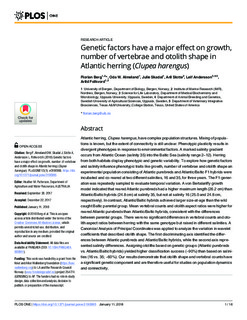Genetic factors have a major effect on growth, number of vertebrae and otolith shape in Atlantic herring (Clupea harengus)
Peer reviewed, Journal article
Published version
Permanent lenke
http://hdl.handle.net/11250/2477612Utgivelsesdato
2018Metadata
Vis full innførselSamlinger
- Articles [3009]
- Publikasjoner fra CRIStin [3056]
Sammendrag
Atlantic herring, Clupea harengus, have complex population structures. Mixing of populations is known, but the extent of connectivity is still unclear. Phenotypic plasticity results in divergent phenotypes in response to environmental factors. A marked salinity gradient occurs from Atlantic Ocean (salinity 35) into the Baltic Sea (salinity range 2–12). Herring from both habitats display phenotypic and genetic variability. To explore how genetic factors and salinity influence phenotypic traits like growth, number of vertebrae and otolith shape an experimental population consisting of Atlantic purebreds and Atlantic/Baltic F1 hybrids were incubated and co-reared at two different salinities, 16 and 35, for three years. The F1-generation was repeatedly sampled to evaluate temporal variation. A von Bertalanffy growth model indicated that reared Atlantic purebreds had a higher maximum length (26.2 cm) than Atlantic/Baltic hybrids (24.8 cm) at salinity 35, but not at salinity 16 (25.0 and 24.8 cm, respectively). In contrast, Atlantic/Baltic hybrids achieved larger size-at-age than the wild caught Baltic parental group. Mean vertebral counts and otolith aspect ratios were higher for reared Atlantic purebreds than Atlantic/Baltic hybrids, consistent with the differences between parental groups. There were no significant differences in vertebral counts and otolith aspect ratios between herring with the same genotype but raised in different salinities. A Canonical Analysis of Principal Coordinates was applied to analyze the variation in wavelet coefficients that described otolith shape. The first discriminating axis identified the differences between Atlantic purebreds and Atlantic/Baltic hybrids, while the second axis represented salinity differences. Assigning otoliths based on genetic groups (Atlantic purebreds vs. Atlantic/Baltic hybrids) yielded higher classification success (~90%) than based on salinities (16 vs. 35; ~60%). Our results demonstrate that otolith shape and vertebral counts have a significant genetic component and are therefore useful for studies on population dynamics and connectivity.
